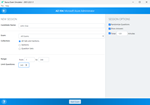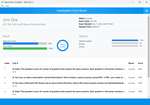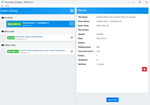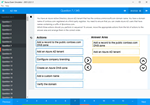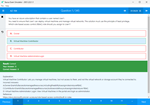Download MuleSoft Certified Developer - Level 2 (Mule 4).MCD-Level-2.VCEplus.2024-04-29.40q.tqb
| Vendor: | Mulesoft |
| Exam Code: | MCD-Level-2 |
| Exam Name: | MuleSoft Certified Developer - Level 2 (Mule 4) |
| Date: | Apr 29, 2024 |
| File Size: | 3 MB |
How to open TQB files?
Files with TQB (Taurus Question Bank) extension can be opened by Taurus Exam Studio.
Purchase
Coupon: TAURUSSIM_20OFF
Discount: 20%
Demo Questions
Question 1
Refer to the exhibit.

What action must be performed to log all the errors raised by the VM Connector?
- Add <AsyncLOgger name='orgroute.extensions vm' level=ERROR'I> inside the Logger tag
- Add <AsyncLOgger name='orgroute.extensions vm' level=ERROR'/> inside the Appenders tag
- Configure <Logger level-'ERROR'/> inside the VM Connector configuration
- Nothing, as error-level events are automatically logged
Correct answer: B
Explanation:
To log all the errors raised by the VM Connector, the developer needs to add an async logger with the name 'org.mule.extension.vm' and the level 'ERROR' inside the appenders tag of the log4j2.xml file. This will enable logging all error-level events generated by the VM Connector to the console appender.Reference: https://docs.mulesoft.com/mule-runtime/4.3/logging-in-mule#configuring-custom-logging-settings To log all the errors raised by the VM Connector, the developer needs to add an async logger with the name 'org.mule.extension.vm' and the level 'ERROR' inside the appenders tag of the log4j2.xml file. This will enable logging all error-level events generated by the VM Connector to the console appender.
Reference: https://docs.mulesoft.com/mule-runtime/4.3/logging-in-mule#configuring-custom-logging-settings
Question 2
A developer deploys an API to CloudHub and applies an OAuth policy on API Manager. During testing, the API response is slow, so the developer reconfigures the API so that the out-of-the-box HTTP Caching policy is applied first, and the OAuth API policy is applied second.
What will happen when an HTTP request is received?
- In case of a cache hit, both the OAuth and HTTP Caching policies are evaluated; then the cached response is returned to the caller
- In case of a cache it, only the HTTP Caching policy is evaluating; then the cached response is returned to the caller
- In case of a cache miss, only the HTTP Caching policy is evaluated; then the API retrieves the data from the API implementation, and the policy stores the data to be cached in Object Store
- In case of a cache miss, both the OAuth and HTTP Caching policies are evaluated; then the API retrieves the data from the API implementation, and the policy does not store the data in Object Store
Correct answer: B
Explanation:
When an HTTP request is received and the HTTP Caching policy is applied first, it checks if there is a cached response for that request in Object Store. If there is a cache hit, meaning that a valid cached response exists, then only the HTTP Caching policy is evaluated and the cached response is returned to the caller without invoking the OAuth policy or the API implementation. If there is a cache miss, meaning that no valid cached response exists, then both the HTTP Caching policy and the OAuth policy are evaluated before invoking the API implementation.Reference: https://docs.mulesoft.com/api-manager/2.x/http-caching-policy#policy-ordering When an HTTP request is received and the HTTP Caching policy is applied first, it checks if there is a cached response for that request in Object Store. If there is a cache hit, meaning that a valid cached response exists, then only the HTTP Caching policy is evaluated and the cached response is returned to the caller without invoking the OAuth policy or the API implementation. If there is a cache miss, meaning that no valid cached response exists, then both the HTTP Caching policy and the OAuth policy are evaluated before invoking the API implementation.
Reference: https://docs.mulesoft.com/api-manager/2.x/http-caching-policy#policy-ordering
Question 3
A system API that communicates to an underlying MySQL database is deploying to CloudHub. The DevOps team requires a readiness endpoint to monitor all system APIs.
Which strategy should be used to implement this endpoint?
- Create a dedicated endpoint that responds with the API status and reachability of the underlying systems
- Create a dedicated endpoint that responds with the API status and health of the server
- Use an existing resource endpoint of the API
- Create a dedicated endpoint that responds with the API status only
Correct answer: A
Explanation:
To implement a readiness endpoint to monitor all system APIs, the developer should create a dedicated endpoint that responds with the API status and reachability of the underlying systems. This way, the DevOps team can check if the system API is ready to receive requests and if it can communicate with its backend systems without errors.Reference: https://docs.mulesoft.com/mule-runtime/4.3/deployment-strategies#readiness-probes To implement a readiness endpoint to monitor all system APIs, the developer should create a dedicated endpoint that responds with the API status and reachability of the underlying systems. This way, the DevOps team can check if the system API is ready to receive requests and if it can communicate with its backend systems without errors.
Reference: https://docs.mulesoft.com/mule-runtime/4.3/deployment-strategies#readiness-probes
Question 4
A developer is working on a project that requires encrypting all data before sending it to a backend application. To accomplish this, the developer will use PGP encryption in the Mule 4 Cryptography module.
What is required to encrypt the data before sending it to the backend application?
- The application needs to configure HTTPS TLS context information to encrypt the data
- The application needs to both the private and public keys to encrypt the data
- The application needs the public key from the backend service to encrypt the data
- The application needs the private key from the backend service to encrypt the data
Correct answer: C
Explanation:
To encrypt the data before sending it to the backend application using PGP encryption, the application needs the public key from the backend service. PGP encryption uses a public-key cryptography system, which means that each party has a pair of keys: a public key and a private key. The public key is used to encrypt data, and the private key is used to decrypt data. Therefore, to encrypt data for a specific recipient (the backend service), the application needs to use the recipient's public key. The recipient can then use its own private key to decrypt the data.Reference: https://docs.mulesoft.com/mule-runtime/4.3/cryptography-pgp To encrypt the data before sending it to the backend application using PGP encryption, the application needs the public key from the backend service. PGP encryption uses a public-key cryptography system, which means that each party has a pair of keys: a public key and a private key. The public key is used to encrypt data, and the private key is used to decrypt data. Therefore, to encrypt data for a specific recipient (the backend service), the application needs to use the recipient's public key. The recipient can then use its own private key to decrypt the data.
Reference: https://docs.mulesoft.com/mule-runtime/4.3/cryptography-pgp
Question 5
A heathcare customer wants to use hospital system data, which includes code that was developed using legacy tools and methods. The customer has created reusable Java libraries in order to read the data from the system.
What is the most effective way to develop an API retrieve the data from the hospital system?
- Refer to JAR files in the code
- Include the libraries writes deploying the code into the runtime
- Create the Java code in your project and invoice the data from the code
- Install libraries in a local repository and refer to it in the pm.xml file
Correct answer: D
Explanation:
To develop an API that retrieves data from a hospital system using reusable Java libraries, the developer should install libraries in a local repository and refer to it in the pom.xml file. This way, the developer can use Maven to manage dependencies and invoke Java code from Mule applications using Java Module operations.Reference: https://docs.mulesoft.com/mule-runtime/4.3/java-module-reference#add-the-java-module-to-your-project https://docs.mulesoft.com/mule-runtime/4.3/java-module-reference#invoke-java-code To develop an API that retrieves data from a hospital system using reusable Java libraries, the developer should install libraries in a local repository and refer to it in the pom.xml file. This way, the developer can use Maven to manage dependencies and invoke Java code from Mule applications using Java Module operations.
Reference: https://docs.mulesoft.com/mule-runtime/4.3/java-module-reference#add-the-java-module-to-your-project https://docs.mulesoft.com/mule-runtime/4.3/java-module-reference#invoke-java-code
HOW TO OPEN VCE FILES
Use VCE Exam Simulator to open VCE files

HOW TO OPEN VCEX FILES
Use ProfExam Simulator to open VCEX files


ProfExam at a 20% markdown
You have the opportunity to purchase ProfExam at a 20% reduced price
Get Now!